
I have the unique privilege of being a third-generation banker. My grandfather started and ran a small savings and loan (“S&L”) in the western suburbs of Chicago. My father followed him into the S&L business and there were days when I would join him at work, handing out toasters and other gifts to those that opened new accounts. Occasionally, we’d go to homes with a rolling measuring tape to measure and appraise the land and house that the S&L provided a mortgage against. Companies in those days also got most of their financing from banks.
I have worked with many financial institutions during my career (at three leading banks) and have learned much over my decades helping companies refine strategy, raise capital, and think about how best to navigate their opportunities and challenges. One dominant theme that I have observed, and that has accelerated over the past decade and in particular over the past 24 months, has been in the “democratization of finance,” or DEFI.
Commercial Financing Providers Continue to Broaden
Today, the financing of businesses is done by an increasingly broad range of entities. Banks are still active and important, but businesses today can get commercial financing options from any of the following non-bank financial institutions (NBFIs):
- BDC (Business Development Company)
- Independent Finance Company
- Captive Finance Company
- Asset Manager
- Insurance Company
- Fintech Lender
- CLO Manager
- Hedge Fund
Some of these lenders are “blending platforms” to better align their clients’ needs with capital availability, investor interests and services. The “democratization of finance” is often occurring under the radar – many of these lenders and financiers have their own balance sheets, but they also partner with other investors to serve the unique needs of their clients. Many lenders increasingly provide solutions ranging from senior debt through equity, as well as offer asset “flow” arrangements. Several asset managers now own insurance companies, which often provide the ability to invest in whole loans, securities and even ownership interests in companies.
Improvements in technology, rising global cash levels, continued low interest rates and the current regulatory environment provide advantages for commercial finance providers, contributing to the overall growth in many sectors, as seen here in leveraged lending:
NBFI Share of Leveraged Loan Originations
(% of Commitments)
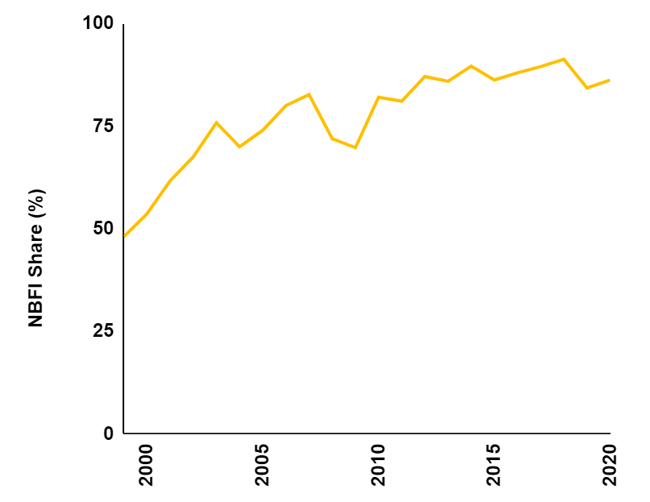
Enhanced regulation around leveraged lending made the sector more challenging for banks, enabling NBFIs to compete more aggressively
Source: SNC, Leveraged Loan Guidance
While the economy is still uncertain and companies face many obstacles including supply chain issues, hiring challenges and the continued impact of the pandemic, recent data from various sectors shows many reasons for economic optimism.
Cause for Optimism in Default and Delinquency Rates
Companies faced numerous stresses, but overall have navigated the COVID-19 pandemic well, except for certain notable pockets. This is something that my leadership team has discussed at length, and our industry research team has observed that most lenders have navigated the past 18+ months well, supported by flexibility, good liquidity management, and government support that helped smaller borrowers in particular.
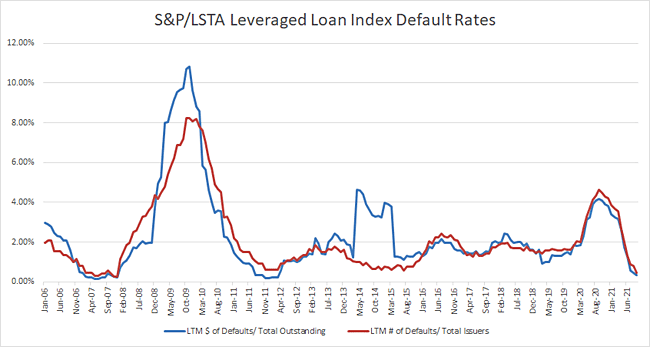
Small business lending performance continues to improve, with PayNet’s Small Business Lending Delinquency Index falling to 1.75%, compared to 2.29% at the end of 2020. Small business delinquencies and defaults spiked at the onset of the pandemic but began to turn around with federal government support and continues to show promise as the economy reopens.
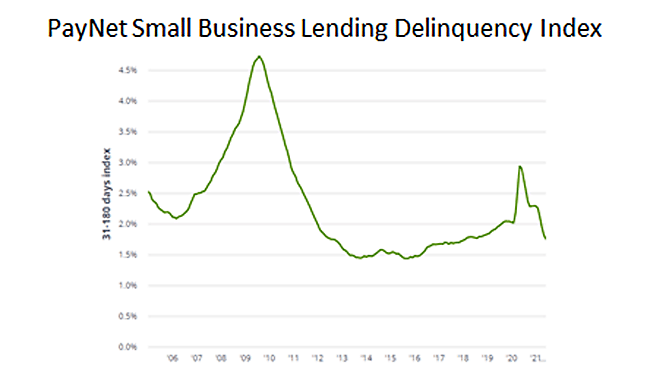
Cause for Optimism in Small Business Finance
Many small businesses have experienced significant pandemic-induced stress in 2020 and 2021, but new business formation is approaching decades highs as many take advantage of the current market to start new businesses. And many existing businesses turned to fintech lenders to secure Paycheck Protection Program loans to help keep their companies afloat.
Within our commercial finance group, we are closely watching the performance of these businesses and lenders, especially as many lenders have developed new tools for sourcing, underwriting and administering loans. In the future, these technology-enabled lenders may be more formidable and important financiers to the needs of businesses.

The NFIB’s Small Business Optimism Index recently fell modestly month-over-month, but reads modestly up from last quarter at 99.7 versus 95.0. Notable quarterly movements include rising plans to increase employment and the increasing belief that now is a good time to expand. More recent data shows that optimism warrants caution, however, with some consumer businesses seeing reduced traffic with concerns over the Delta variant.
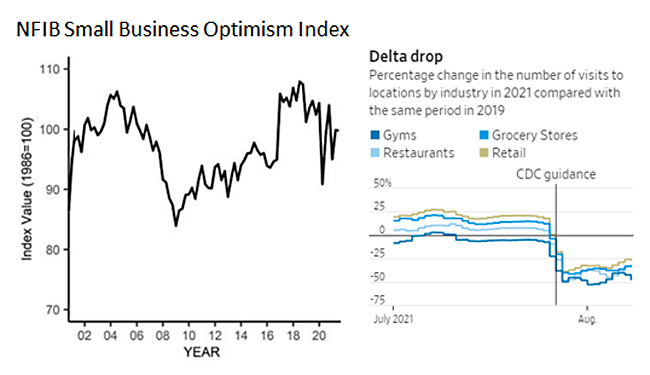
Cause for Optimism in Equipment Finance
The Equipment Leasing and Finance Association’s Monthly Leasing and Finance Index reports new business volume is up 17% from 2020 levels year-to-date. ELFA reported potential headwinds in the second half including low vaccination rates, upticks in inflation, and supply chain/labor issues. These headwinds are being offset by rising investment, rising confidence, and reopening in many parts of the economy.
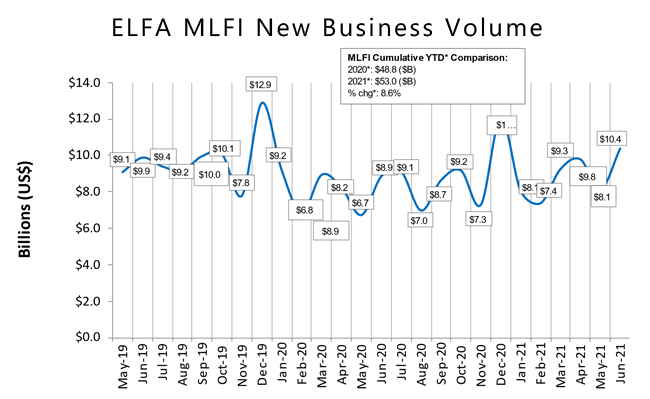
GDP Source: U.S. Bureau of Economic Analysis
Monthly Leasing and Finance Index Source: Equipment Leasing and Finance Association
Overall, since March 2020, we have observed a general acceleration of trends that are transforming commercial finance. While banks are both direct and indirect supporters of many commercial finance markets, we see continued growth and evolution of commercial finance organizations that are serving the needs of their clients, often in improved ways. We believe those trends will continue, and technology and focus will be key differentiators over time. It’s exciting to see how the “democratization of finance” continues to transform how commercial finance providers deliver capital and other services to their clients, and we see this evolution as part of one of the more exciting periods in commercial finance.